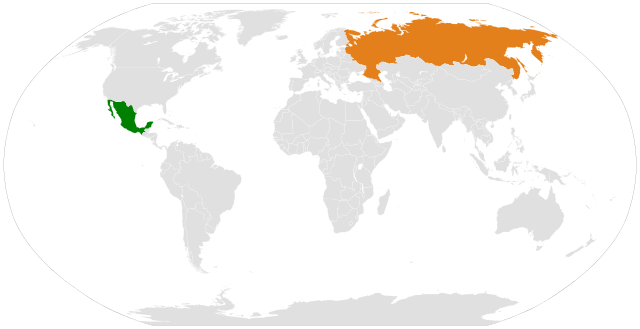by Alec Dubro
I first came to Mexico in 1964 and have visited probably a dozen times. With each succeeding visit, I’ve seen the country grow richer and more developed, expanding its educational and cultural institutions and growing its middle class. Many of us know that Mexico is far more than its many poor people and its endless drug wars.
That of course doesn’t include Donald Trump. His view of Mexico is of a pathetic and inept country, full of dark and menacing people, broken only by an archipelago of attractive resorts. And he sees it as disgracefully poor—else why would so many want to rush north and take our jobs. If it’s not exactly in the shithole league, it’s nearby.
On the other hand, to Trump and his acolytes, Russia is a mighty power with a much-feared arsenal and a legendary space program. It’s led by a fearsome and unopposable dictator who dispatches his enemies with the help of an army of thugs. And, it’s agreeably filled with nouveau-riche billionaires and suppliant, glimmering women. Oh, and it’s thoroughly and proudly white.
If these views were confined to Trump, it would be merely another of his appalling views. Unfortunately, these are held to some extent by a large segment of the country, and they distort our relations with both.
Why compare these two seemingly disparate nations? Because, in many respects, they’re surprisingly similar, being differentiated much more by image than salient characteristics. Let’s compare.
For one thing, they have roughly comparable populations: Russia 144 million; Mexico 127 million. This may surprise people with enlightened views of Mexico because of the vastly different geographical sizes of both countries—exaggerated by the Mercator maps we all grew up with.
More surprising is their respective GDP. According to 2016 World Bank figures, Russia is twelfth overall with $1.28 trillion. Mexico is not far behind at 15th with $1.04 trillion. And when corrected for population, they grow even closer. As a result, the official per capita GDPs are, according to the bank: $8,748 for Russians and $8,201 for Mexicans. There is some discrepancy between the aggregate and individual figures, but the results show an unanticipated vicinity.
These published numbers are in no way precise. Both Russia and Mexico have large informal economies that, by their natures, evade convincing estimation. But informal economy is more a function of poverty that lives beyond banking and government. And poverty and crime are things both countries have in excess, complicating evaluation even more.
Although the GDPs are similar adjusted for population, their export economies are very different. Russia is primarily an exporter of petroleum products and raw materials, while Mexico has a diversified export economy relying on food, automobiles, heavy machinery, petroleum, electronics and, increasingly, IT. Its once-dominant petroleum sector has diminished as a proportion of its foreign earnings, but its economic future looks bright. Not so Russia, whose only significant manufactures are in aerospace and armaments. In short, what they’re selling, nobody’s buying.
But wealth is much more evident in what’s called, for convenience sake, the middle class. And here, Mexico holds a significant edge.
“According to the Russian State Statistics Committee, the middle class makes up no less than 20 percent of society,” writes Maria Fyodorova of ITAR-TASS. The problem though, is that the Russian middle class is largely populated by civil servants and various functionaries. Professionals and small-scale entrepreneurs are much less in evidence than in most of the developed world.
Mexico, on the other hand, has a middle class that includes many skilled workers, professionals, entrepreneurs, artists and, yes, functionaries. Estimates of the size of this group aren’t consistent. However, according to a 2012 Washington Post story: The OECD “considers Mexico 50 percent middle class, based on median incomes… Then there’s another gauge: self-perception. According to the latest surveys, 65 percent of Mexicans see themselves as ‘middle class’ today.” No comparable statistic exists in Russia.
Let’s look at another comp: life expectancy—except here it isn’t really even close. According to the 2016 CIA stats, Russia’s is 70.3 years and Mexico’s is 75.9. In other words about six significant years separate them.
Russia has about twice as many doctors per capita than Mexico, but most reports say Russia’s system is far more corrupt and underfunded. Mexico made a decision years ago to lower the infant mortality rate and by any measure succeeded, which increased overall life expectancy. In both countries people—that is to say, men—drink a lot, but only in Russia is it a major cause of shortened life spans.
Mexico does indeed have a high murder rate, although it’s not as high as some other Latin American and African countries. But Mexico’s rate is extraordinary because of the more or less permanent peasant revolt financed by the drug trade. In Russia, the murder rate is much lower; Mexicans kill other Mexicans, but Russians kill themselves. The suicide rate in Russia is 18 per 100,000 people, according to recent World Health Organization statistics—the highest of any major European country.
Neither country has an admirable level of democracy, but most Mexican elections bear some resemblance to actual votes cast, and candidates for president aren’t routinely jailed.
Mexico’s culture is well funded and has admirers throughout the world. Its visual arts are recognizable and have historically received federal and state funding. Russia, too, supports and encourages the arts and has a rich history, but Russia exercises greater censorship (although no one actually knows what the rules are or how widespread it is). So, let’s generously call it a draw.
So, what is the principal difference? Guns. Russia has over 3 million people under arms, although more than two-thirds of them are reservists, plus strategic air and naval forces. And it spends an estimated $70 billion a year on them. Mexico, on the other hand, spends $15 billion on a military that’s solely for domestic uses and that has fewer than 300,000 active service members.
So, in short, Russia is highly regarded by the Donald Trumps of the world because it is a military power—and not much else. But that alone seems to qualify Russia for inclusion in BRICS. By most other measures, Mexico, not Russia, should be in that group. However, BMICS doesn’t have the same ring, does it?
And, of course, because it’s white—very white. As I wrote earlier in LobeLog, the bond between the US far right and Russia—or, at least a mental simulacrum of Russia—goes deep. But even those of us who aren’t in thrall to spiritual whiteness can hold views of Russia and Mexico based on stereotypes that obscure a more accurate understandings of the countries. Mexico is not only admirable in many ways and a nation of substance, it’s also our neighbor and a strong part of the US. Russia, too, has its strengths—besides its military—but it’s not as a whole more successful than Mexico.
Time for a reevaluation.
Alec Dubro is a writer based in Washington, D.C.






Well, a couple of other statistics:
If one assesses that GDP adjusted by purchasing power parity is a better gauge of economic value, then Russia number 6 (roughly on par with Germany) while Mexico is considerably lower at number 11. Mexicos GPD adjusted by PPP is about 55% of Russias.
The core difference is that Mexico is effectively an economic annex of the USA, while Russia is its own economic core. This is one of the core things which sets it apart from other countries with comparable economies. It is also why Russia punches so far above its own economic weight.
The whole “white” thing is weird for me as a half Russian since well, Russians will typically regard Mexicans/Spaniards etc. as white. I would further add that Russia is far from homogenous ethnically, and is not even particularly homgenous in its leadership (while Putin is ethnic Russian, Sergej Lavrov is half Armenian, Sergei Shoigu is Tuvan, Vladislav Surkov is Chechen, Tuvans do not “count” as whites in either Russian or American definitions of white, and Chechens arent white as far as Russians are concerned).
And well, militarily, Mexico and Russia simply arent comparable.